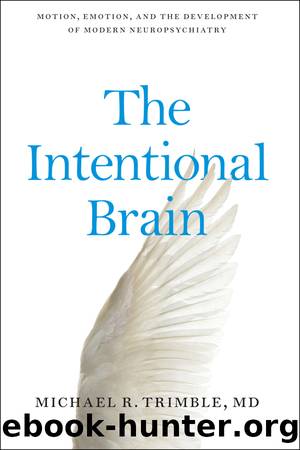The Intentional Brain by Michael R. Trimble

Author:Michael R. Trimble
Language: eng
Format: epub
ISBN: 9781421419503
Publisher: Johns Hopkins University Press
NOTES
1. The First Folio of 1623.
2. For example, see the discussion in Julian Youngâs recent excellent biography (Young J, 2010).
3. These ideas of the supposed equipotentiality stress patterns of CNS activity rather than segregated loci of excitation, prefiguring later theories of Gestalt psychology, gradients of neural activity, and the mutual influence of neighboring parts of the brain on each other.
4. There are several accounts of this, and that of Critchley M, 1979, is quoted here.
5. Nobody who had attended the congress where Dax claimed his father had read his paper could recall a Dr. Dax.
6. The details and quotations are given in Joynt R, 1982.
7. McHenry LC, 1969, 219, 223.
8. This is the refrain and the last line of Zolaâs Nana. The second French Empire collapsed and decayed (in Zolaâs view), as did Nanaâs body, as she became disfigured and died from smallpox. The French government had just declared war on Prussia, as the name of Bismarck is repeated in the story. The French lost.
9. In 1870 Bismarck started a war against France in a continuation of the old conflicts between the two countries. The Second Reich came into being as German unification proceeded.
10. For a very thorough discussion of the German genius, there can be no better book than Watson P, 2010; quote on 53â54.
11. Griesinger W, 1867, 1, 9, 413.
12. Hughlings Jackson had described apraxia before Liepmann in 1861, but Liepmann gave more detailed descriptions and subtypes.
13. On Auguste Forel, see Ellenberger H, 1970, 434.
14. These later became also referred to as isocortex and allocortex (the classification of Oskar Vogt [1870â1959] and Cécile Vogt [1875â1962]).
15. The Golgi method of silver staining revealed axonic nets and neurons. Nisslâs methylene blue method gave even better delineation of cell bodies.
16. Clarke E, OâMalley CD, 1968, 552.
17. See Benson DF, 1997.
18. There are debates as to whether or not Freud became addicted to cocaine. His English analyst collaborator Ernest Jones (1879â1958) estimated that Freud used the drug on and off for some 15 years. The way this may have influenced his creative thinking and his dreams is a matter of speculation.
19. Stone I, 1971, 183â184.
20. See Ellenberger H, 1970.
21. For an account of the battle between Erichsen and Page and the history of posttraumatic neurosis, see Trimble MR, 1981. Other good references are found in Micale MS, Lerner P, 2001.
22. There is much written about this, but the translation by Stengel E, 1953, as well as the excellent small book by Dewhurst K, 1982, covers the important ground. The book was not well received, and only 142 copies were sold in the first year and 115 in the following nine.
23. Freud went on to clarify his view that Charcotâs attribution of hereditary neuropathic influences to both organic disorders and the neuroses failed to understand the etiological and nosological differentiation of the neuroses. Obsessions and phobias were true neuroses, with different etiologies, and he distinguished anxiety neuroses from neurasthenia. The causes were revealed by psychological analysis, leading to his later insistence that the
Download
This site does not store any files on its server. We only index and link to content provided by other sites. Please contact the content providers to delete copyright contents if any and email us, we'll remove relevant links or contents immediately.
| Administration & Medicine Economics | Allied Health Professions |
| Basic Sciences | Dentistry |
| History | Medical Informatics |
| Medicine | Nursing |
| Pharmacology | Psychology |
| Research | Veterinary Medicine |
Bioenergetica by Alexander Lowen(1423)
The Child in You by Stefanie Stahl(1200)
No Bad Parts by Richard C. Schwartz(1170)
Noise: A Flaw in Human Judgment by Sunstein Cass R. & Sibony Olivier & Kahneman Daniel(1153)
The Data Detective by Tim Harford(1099)
Chatter by Ethan Kross(1022)
The Science of Rapid Skill Acquisition by Peter Hollins(870)
The Quantum Psychiatrist: From Zero to Zen Using Evidence-Based Solutions Beyond Medication and Therapy by Biswas Dona(832)
Freedom by Sebastian Junger(813)
The Montessori Baby by Simone Davies(787)
Maps of Meaning: The Architecture of Belief by Jordan B. Peterson(705)
The Science of Self-Learning: How to Teach Yourself Anything, Learn More in Less Time, and Direct Your Own Education (Learning how to Learn Book 1) by Peter Hollins(688)
Evolution Gone Wrong: The Curious Reasons Why Our Bodies Work by Alex Bezzerides(672)
Sadomasochism and the BDSM Community in the United States by Stephen K. Stein(651)
Anxiety For Dummies by Charles H. Elliott & Laura L. Smith(634)
Why Sex Doesn't Matter by Olivia Fane(627)
Disconnected by thomas Kersting(619)
Jung - The Key Ideas: Teach Yourself (TY Philosophy) by Ruth Snowden(592)
The Mechanics of Passions: Brain, Behaviour, and Society by Alain Ehrenberg(590)
